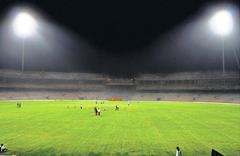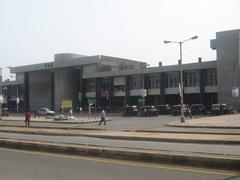Navi Mumbai International Airport Visiting Hours, Tickets, and Travel Guide
Date: 14/06/2025
Introduction to Navi Mumbai International Airport
Navi Mumbai International Airport (NMIA), officially named Loknete DB Patil Navi Mumbai International Airport, represents a major milestone for India’s aviation sector. Designed to alleviate the congestion at Mumbai’s Chhatrapati Shivaji Maharaj International Airport (CSMIA), NMIA is set to become a world-class air travel hub with state-of-the-art infrastructure, innovative design by Zaha Hadid Architects, and a strong commitment to environmental sustainability. Strategically located near Panvel, the airport is expected to enhance connectivity, drive economic growth, and foster regional development across Maharashtra and Western India.
This guide provides detailed insights into NMIA’s vision, development, visiting hours, ticketing, accessibility, facilities, connectivity, and surrounding attractions, making it an essential resource for travelers, aviation enthusiasts, and regional planners.
For authoritative background and visual references, see Travel and Tour World and Architectural Digest.
Table of Contents
- Introduction
- Vision and Rationale for NMIA
- Project Development and Stakeholders
- Land Acquisition & Community Impact
- Environmental & Engineering Challenges
- Architecture and Terminal Design
- Construction Timeline & Milestones
- Infrastructure and Connectivity
- Visitor Information
- Attractions Near NMIA
- Guided Tours & Visitor Experiences
- Economic & Regional Significance
- Integration with Mumbai’s Aviation Network
- Frequently Asked Questions (FAQ)
- Conclusion & Call to Action
- References
Vision and Rationale for Navi Mumbai International Airport
The demand for a second international airport in Mumbai arose from the overwhelming capacity constraints at CSMIA, which has been handling over 50 million passengers annually. Mumbai’s rapid urbanization and its stature as India’s financial capital necessitated a new, larger, and technologically advanced airport. Navi Mumbai, a meticulously planned satellite city, was chosen for its proximity to Mumbai, ample land, and potential for seamless infrastructure integration with the broader metropolitan region.
Project Development and Stakeholders
The NMIA project was approved by the Maharashtra government in 2008, with CIDCO appointed as the nodal agency. Developed under a public-private partnership (PPP) and the DBFOT (Design, Build, Finance, Operate, and Transfer) model, the ownership is split between Adani Airport Holdings Limited (74%) and CIDCO (26%). The estimated investment is ₹16,700 crore (approx. US$2 billion), with operational rights spanning 30 years, extendable by another 30.
Land Acquisition & Community Impact
The airport spans 1,160 hectares near Panvel, necessitating the relocation of several villages. Advocacy by Dinkar Balu Patil led to comprehensive rehabilitation packages, including new housing, amenities, and employment opportunities. NMIA is projected to create over 400,000 direct and indirect jobs, stimulating significant economic and social upliftment in Navi Mumbai and the surrounding regions.
Environmental & Engineering Challenges
Given NMIA’s proximity to wetlands, mangroves, and the Ulwe River, extensive environmental impact assessments were conducted. Key measures include mangrove transplantation, compensatory plantations, and river diversion to mitigate flood risks. Advanced engineering solutions for land leveling, soil stabilization, and monsoon-proof drainage have been implemented, reflecting a commitment to sustainability through rainwater harvesting and energy-efficient design.
Architecture and Terminal Design
Designed by Zaha Hadid Architects, NMIA’s terminal draws inspiration from the lotus flower, symbolizing India’s cultural heritage and spirit of renewal. The master plan features four terminals and two parallel runways (each 3,700 x 60 meters), with phased expansion from an initial capacity of 20 million passengers per year to a target of 90–100 million by 2032. The interior boasts natural lighting, expansive glass facades, and intuitive wayfinding systems (Architectural Digest).
Construction Timeline & Milestones
- 2018: Foundation stone laid by Prime Minister Narendra Modi.
- 2021: Construction commenced.
- December 2024: Successful test landing of an IndiGo A320.
- April 2025: Planned inauguration.
- May 2025: Commencement of domestic operations.
- July 2025: Expected launch of international flights (subject to regulatory approvals).
Phased construction ensures scalable development without disrupting ongoing operations (Travel and Tour World).
Infrastructure and Connectivity
NMIA is positioned approximately 30–40 km southeast of central Mumbai, accessible via National Highway 4B, Sion-Panvel Expressway, and the Mumbai Trans Harbour Link (MTHL). Multimodal connectivity includes:
- Road: Enhanced expressways, flyovers, and dedicated lanes.
- Rail: Proximity to Panvel suburban railway station.
- Metro: Proposed Gold Line 8 and Navi Mumbai Metro Line 1 (pending final approvals).
- Coastal Roads: Under development for improved access.
- Parking: Multi-level facilities, dedicated app-based taxi zones (Times Property).
Visitor Information
Visiting Hours
- Airport Operations: 24/7 for international and domestic flights.
- Terminal Services: Most retail and dining outlets open from 5 AM to 11 PM; select services operate round the clock.
- Check-in Counters: Open three hours before international flights, two hours for domestic flights.
Ticketing
- Tickets for NMIA flights are available via airline websites, travel agencies, and online portals.
- Self-service kiosks and manned counters are provided onsite for added convenience.
- For guided tours and special events, visit the official NMIA website.
Accessibility & Amenities
- Barrier-Free Access: Ramps, tactile flooring, elevators, accessible restrooms, and reserved parking.
- Passenger Services: Lounges, prayer rooms, medical centers, currency exchange, and free Wi-Fi.
- Assistance: Trained staff for travelers with reduced mobility.
Travel Tips
- Arrive at least 3 hours before international and 2 hours before domestic flights.
- Use official airport transport, especially during peak hours.
- Keep travel documents and tickets easily accessible for security checks.
- Download the official NMIA app for real-time updates.
Attractions Near NMIA
Explore the cultural and natural attractions in the vicinity:
- Panvel: Historic town with temples and local markets.
- Ulwe: Scenic landscapes and proximity to the airport.
- Mumbai’s Heritage Sites: Gateway of India, Elephanta Caves, Marine Drive, all easily accessible from NMIA.
The airport’s lotus-shaped terminal and futuristic architecture offer excellent opportunities for photography.
Guided Tours & Visitor Experiences
After opening, NMIA will offer guided tours that highlight its architectural innovation, sustainability initiatives, and operational excellence. Details and schedules will be available on the airport’s official website.
Economic & Regional Significance
NMIA is expected to anchor an aerotropolis, integrating commercial, residential, and industrial zones. With cargo terminals projected to handle up to 2.5 million tonnes annually, the airport will significantly boost Mumbai’s role as a logistics and trade hub. The project’s ripple effects include job creation, increased GDP, urban development, and a vibrant ecosystem for allied industries (Akbar Travels; RealtyNMore).
Integration with Mumbai’s Aviation Network
NMIA and CSMIA will operate as a coordinated dual-airport system under Adani Airport Holdings, optimizing resources and offering seamless connectivity for travelers. This approach positions Mumbai among the world’s foremost aviation gateways (Aviation Today).
Frequently Asked Questions (FAQ)
Q: What are the visiting hours at Navi Mumbai International Airport?
A: NMIA operates 24/7; most public facilities are available from 5 AM to 11 PM.
Q: How do I buy tickets for flights from NMIA?
A: Tickets are available via airline websites, travel agencies, and authorized online portals.
Q: Is NMIA accessible for differently-abled passengers?
A: Yes, NMIA features barrier-free design, ramps, elevators, accessible restrooms, and staff assistance.
Q: What are the transport options to NMIA?
A: Reach NMIA by road (NH 4B, Sion-Panvel Expressway, MTHL), suburban rail, and (pending completion) metro lines.
Q: Are guided tours available?
A: Guided tours will be offered post-opening; check the NMIA website for updates.
Q: What attractions are near NMIA?
A: Explore Panvel, Ulwe, and Mumbai landmarks like the Gateway of India and Elephanta Caves.
Conclusion & Call to Action
Navi Mumbai International Airport is set to transform Mumbai’s air travel landscape, offering cutting-edge amenities, seamless connectivity, and a commitment to sustainability. As the airport approaches its inauguration, travelers should stay updated via the official NMIA website and the Audiala app for real-time information, travel tips, and exclusive offers.
Plan your journey to NMIA to experience the future of Indian aviation. Download the Audiala app, follow us on social media, and explore our related guides for the latest news and travel insights.
References and Further Reading
- Navi Mumbai International Airport Official Site
- Travel and Tour World: NMIA Passenger Experience & Economic Impact
- Akbar Travels: NMIA All You Need to Know
- Architectural Digest: NMIA and Noida Airport Preview
- Aviation Today: NMIA Multimodal Connectivity
- The Metro Rail Guy: NMIA Status and Design
- Times Property: Everything About NMIA
- RealtyNMore: NMIA Economic Impact

